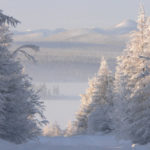16 interesting facts about the Tunguska meteorite
 Until now, no one knows what the Tunguska meteorite was. The debate is even about whether he was at all, because studying the place of his alleged fall brought amazing results – ordinary meteorites do not behave like that. And still it is impossible to say with certainty whether this riddle will be solved at least sometime.
Until now, no one knows what the Tunguska meteorite was. The debate is even about whether he was at all, because studying the place of his alleged fall brought amazing results – ordinary meteorites do not behave like that. And still it is impossible to say with certainty whether this riddle will be solved at least sometime.
Despite the fact that more than a hundred years have passed since its fall, trees still do not grow there. Moreover, around the place of fall, the fallen taiga has long ago grown anew, and the epicenter itself still represents a plain meadow without a single tree. Why is not known.
The impact from the fall of the Tunguska meteorite was so powerful that even seismographs located in Germany recorded seismic vibrations from it.
After the fall of the Tunguska meteorite, millions of people saw with their own eyes the northern lights over Greece and Spain. This is generally not possible, at least under normal conditions. However, this has happened.
During the explosion of the meteorite, such an amount of light energy was released that the forest around the epicenter instantly flared up, and a terrible fire destroyed everything that was there.
Not a single piece of the Tunguska meteorite was found, although searches have been conducted for more than a century.
His explosion was so powerful that it entailed a strong perturbation of the Earth’s magnetic field. As a result, radio outages have been observed in different parts of the world for more than five hours.
Some believe that in fact, not a meteorite, but a UFO crashed into the earth.
In the 20th century, the theory was advanced that the Tunguska meteorite was a shallow wandering black hole.
An event similar to the fall of the Tunguska meteorite occurred in Brazil after a couple of decades. But there the fall fell on a very inaccessible area, and the case was quickly hushed up.
There is no impact crater at the site of the fall of the Tunguska meteorite. However, this can be explained by the fact that it consisted of ice, and upon impact it completely evaporated.
According to another theory, there was no meteorite, but there was an explosion of underground natural gas that burst to the surface. But this version is contrary to the fact that many people saw a huge flaming ball in the sky.
Some scientists believe that the Tunguska meteorite was a comet. This version has the right to life, especially since a few days before the incident in the sky there were unusual natural phenomena like too bright dusk over Siberia, where the blow came, and a bright halo in the sky.
The shock wave after the fall of the Tunguska meteorite increased the glass in houses within a radius of two hundred kilometers, and also tumbled the taiga on an area of 2200 square meters. km
Studies have shown that there was no collision of the meteorite with the earth’s surface. Apparently, he exploded before reaching the ground for seven to ten kilometers.
The explosion power of the Tunguska meteorite was, according to approximate estimates, about 50 megatons of TNT, which is comparable to the power of the most powerful hydrogen bomb ever exploded on Earth in the course of testing.
This incident got its name in honor of the Podkamennaya Tunguska River.



























